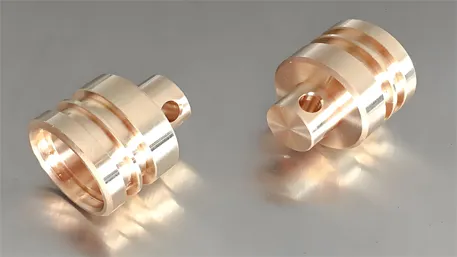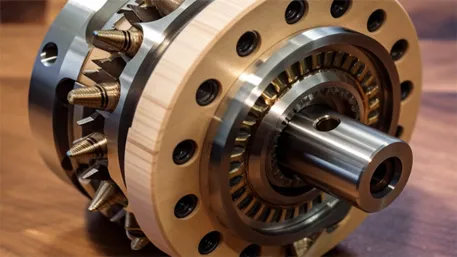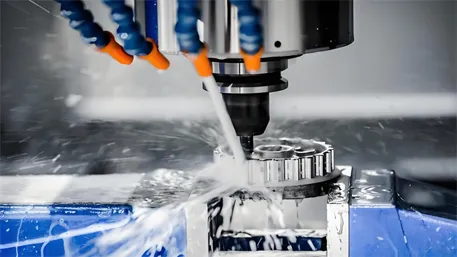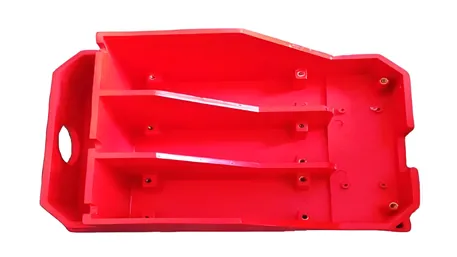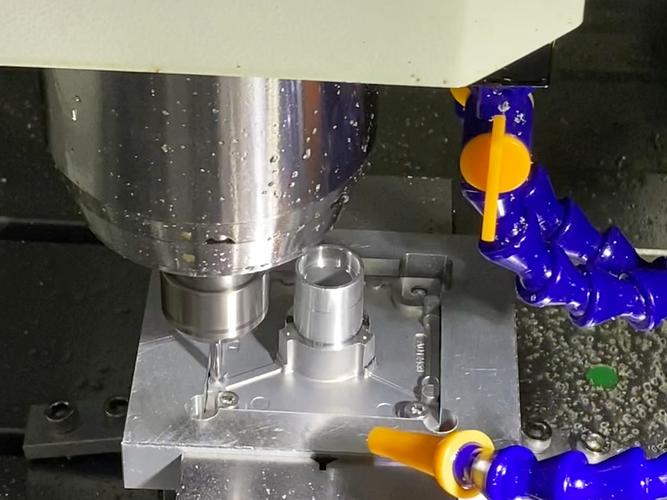
- Cutting Speed (Vc): The linear speed of the tool’s cutting edge relative to the workpiece (measured in m/min or ft/min). It controls how fast the tool “cuts” through material and directly impacts heat generation.
- Spindle Speed (S): The rotational speed of the tool (measured in r/min). It is derived from cutting speed and tool diameter (not set arbitrarily).
- Feed Rate (F): The linear speed at which the tool advances into the workpiece (measured in mm/min or ipm). It controls material removal rate and chip formation.
- Tool Life: A 20% increase in cutting speed can reduce carbide tool life by 50% (Source: 2025 CNC Tool Wear Study).
- Hole Quality: Too slow a feed rate causes “rubbing” (cloudy holes in acrylic); too fast causes chipping (in aluminum) or tool breakage (in steel).
- Efficiency: Optimized feeds/speeds cut cycle time by 30-40% vs. “safe” (overly slow) parameters—critical for high-volume production.
2. Key Fundamentals: Calculating Feeds and Speeds
A. Step 1: Calculate Spindle Speed (S) from Cutting Speed (Vc)
- 1000: Converts mm to meters (since Vc is in m/min).
- π × D: Circumference of the tool (distance the cutting edge travels per revolution).
B. Step 2: Calculate Feed Rate (F)
- fz: Feed per tooth (mm/tooth) — the amount of material each flute removes per revolution (varies by material and tool).
C. Critical Variables That Impact Calculations
|
Variable
|
Impact on Feeds/Speeds
|
|
Material Hardness
|
Harder materials (e.g., 7075 aluminum, 4140 steel) require lower Vc (reduce by 20-30%).
|
|
Tool Material
|
Carbide tools handle 2-3× higher Vc than HSS (e.g., Vc=120 m/min for carbide vs. 40 m/min for HSS in steel).
|
|
Hole Depth
|
Deep holes (>5×D) need 10-15% lower F (to improve chip evacuation and reduce tool stress).
|
|
Workpiece Rigidity
|
Thin/wobbly parts (e.g., 1mm aluminum sheets) need 15-20% lower S and F (prevent vibration).
|
3. Material-Specific Feeds and Speeds (Practical Reference Tables)
A. Steel & Stainless Steel (Hard Materials)
|
Material
|
Tool Type
|
Tool Diameter (D)
|
Cutting Speed (Vc)
|
Spindle Speed (S)
|
Feed per Tooth (fz)
|
Feed Rate (F)
|
|
45# Steel (HB200)
|
Carbide Twist Drill
|
φ5mm
|
100-120 m/min
|
6369-7643 r/min
|
0.08-0.10 mm/tooth
|
509-764 mm/min
|
|
45# Steel (HB200)
|
HSS Twist Drill
|
φ5mm
|
30-40 m/min
|
1909-2546 r/min
|
0.05-0.07 mm/tooth
|
95-178 mm/min
|
|
304 Stainless Steel
|
Carbide Twist Drill
|
φ5mm
|
60-80 m/min
|
3819-5092 r/min
|
0.06-0.08 mm/tooth
|
229-407 mm/min
|
B. Aluminum Alloys (Soft, High Thermal Conductivity)
|
Material
|
Tool Type
|
Tool Diameter (D)
|
Cutting Speed (Vc)
|
Spindle Speed (S)
|
Feed per Tooth (fz)
|
Feed Rate (F)
|
|
6061-T6 Aluminum
|
Carbide Twist Drill
|
φ5mm
|
300-400 m/min
|
19098-25464 r/min
|
0.15-0.20 mm/tooth
|
5729-10185 mm/min
|
|
7075-T6 Aluminum
|
Carbide Twist Drill
|
φ5mm
|
200-250 m/min
|
12732-15915 r/min
|
0.12-0.15 mm/tooth
|
3055-4774 mm/min
|
|
6061-T6 Aluminum
|
HSS Twist Drill
|
φ5mm
|
100-120 m/min
|
6369-7643 r/min
|
0.10-0.12 mm/tooth
|
1273-1834 mm/min
|
C. Plastics (Acrylic, PVC—Low Melting Point)
|
Material
|
Tool Type
|
Tool Diameter (D)
|
Cutting Speed (Vc)
|
Spindle Speed (S)
|
Feed per Tooth (fz)
|
Feed Rate (F)
|
|
Acrylic (PMMA)
|
Single-Flute Carbide
|
φ5mm
|
150-200 m/min
|
9549-12732 r/min
|
0.20-0.25 mm/tooth*
|
3819-6366 mm/min
|
|
PVC
|
Carbide Twist Drill
|
φ5mm
|
120-150 m/min
|
7643-9549 r/min
|
0.18-0.22 mm/tooth
|
2751-4191 mm/min
|
4. Practical Case: Optimizing Feeds/Speeds for Drilling 45# Steel (φ8mm Hole)
Step 1: Define Requirements
- Material: 45# steel (Vc = 120 m/min, from Table A).
- Tool: φ8mm carbide twist drill (Z=2 flutes, fz=0.10 mm/tooth).
- Hole Depth: 10mm (≤5×D, so no need to reduce F).
Step 2: Calculate Spindle Speed (S)
Step 3: Calculate Feed Rate (F)
Step 4: Program Snippet (FANUC System)
Step 5: Verify Results
- Tool Life: Carbide drill lasts 800+ holes (vs. 500 holes with under-speeding).
- Hole Quality: Diameter tolerance H8 (φ8+0.013/0), surface roughness Ra=1.6μm.
- Cycle Time: 2.1 seconds/hole (vs. 3.5 seconds with “safe” parameters).
5. Common Feeds/Speeds Mistakes & Solutions
1. Tool Breaks Immediately (Steel/Aluminum)
- Cause: Feed rate too high (exceeds tool’s load capacity) or spindle speed too low (tool “binds” in material).
- Solution:
-
- Reduce F by 30% (e.g., from 950 mm/min to 665 mm/min for 45# steel).
-
- Increase S by 10% (e.g., from 4800 r/min to 5280 r/min) to improve cutting efficiency.
2. Tool Wear Fast (Stainless Steel/7075 Aluminum)
- Cause: Cutting speed too high (generates excess heat) or feed rate too low (tool rubs, not cuts).
- Solution:
-
- Reduce Vc by 20% (e.g., from 80 m/min to 64 m/min for 304 stainless steel).
-
- Increase fz by 10% (e.g., from 0.08 mm/tooth to 0.088 mm/tooth) to promote “chip lifting” (reduces friction).
3. Cloudy Holes (Acrylic/PVC)
- Cause: Cutting speed too low (tool dwells, melts plastic) or feed rate too slow (rubbing, not cutting).
- Solution:
-
- Increase S by 20% (e.g., from 9500 r/min to 11400 r/min for acrylic).
-
- Increase F by 15% (e.g., from 3800 mm/min to 4370 mm/min) to reduce contact time.
4. Chipping at Hole Exit (Aluminum/Thin Steel)
- Cause: Feed rate too high (excessive force on exit) or no pilot hole.
- Solution:
-
- Reduce F by 20% in the last 2mm of depth (use G91 incremental mode: G91 G01 Z-2 F760).
-
- Drill a pilot hole (φ4mm for φ8mm final hole) to reduce exit force.
6. Q&A: High-Frequency Feeds/Speeds Questions
Q1: I don’t have time to calculate—what’s a “quick reference” for beginners?
- Use these “rule-of-thumb” Vc values (carbide tools):
-
- Steel: 100-120 m/min.
-
- Aluminum: 300-400 m/min.
-
- Acrylic: 150-200 m/min.
- Then use a CNC calculator app (e.g., “CNC Feeds and Speeds Calculator”) to auto-generate S and F.
Q2: How to adjust feeds/speeds for deep holes (>10×D, e.g., φ5mm×60mm)?
- Cutting Speed: Reduce Vc by 10% (avoids heat buildup in deep holes).
- Feed Rate: Reduce F by 15-20% (improves chip evacuation—use peck drilling G83 with Q=3-4mm).
- Coolant: Use high-pressure internal coolant (5-8 bar) to flush chips.
Q3: Why do feeds/speeds differ for HSS vs. carbide tools?
- Carbide has a higher melting point (2800°C vs. 1400°C for HSS) and hardness (HRC90+ vs. HRC60-65 for HSS). This allows carbide to handle 2-3× higher Vc—critical for efficiency.
- HSS is cheaper but softer: Use lower Vc (30-50% of carbide) to avoid rapid dulling.

